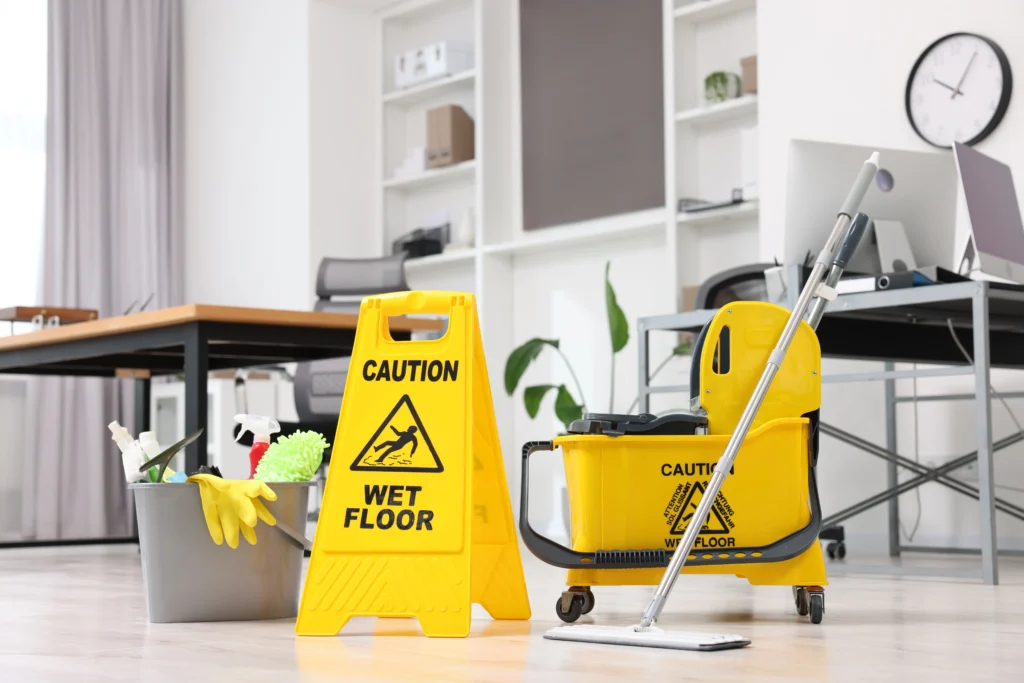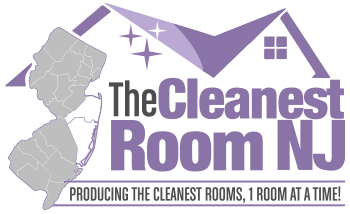The completion of a construction or renovation project is an exciting milestone, but it often leaves behind a host of hidden hazards that can impact your health and safety.
While the visible dust and debris are obvious targets for cleaning, numerous less apparent areas require attention to ensure a truly safe living environment.
This comprehensive guide outlines the critical areas to focus on during post-construction cleaning, highlighting potential risks and offering effective cleaning strategies.
1. Air Quality Management:
Beyond the Visible Dust

Wet Floor Sign And Bucket With Supplies
Construction activities release a myriad of particles into the air, many of which are too small to be seen but can pose significant health risks.
Key Areas of Concern:
- HVAC Systems: Construction dust can infiltrate ductwork and system components, potentially circulating contaminants throughout your home.
- Air Filters: Standard filters may be overwhelmed by the volume of post-construction particulates.
- Hidden Surfaces: Dust can settle on top of cabinets, ceiling fan blades, and other elevated surfaces, becoming a reservoir for ongoing air contamination.
Cleaning Strategies:
- Engage professional HVAC cleaning services to thoroughly clean ductwork and system components.
- Replace all air filters with high-efficiency HEPA filters.
- Use a top-down cleaning approach, starting with ceiling fans and working your way down to capture falling dust.
Implementing these strategies can significantly reduce the risk of respiratory issues and allergic reactions associated with post-construction air quality problems.
2. Surface Residues: Invisible Chemical Traces
Construction materials often leave behind chemical residues that may not be immediately apparent but can off-gas over time, affecting indoor air quality.
Key Areas of Concern:
- New Flooring: Adhesives and finishes can emit volatile organic compounds (VOCs).
- Painted Surfaces: Fresh paint may continue to release fumes for several weeks.
- Newly Installed Cabinetry: Composite wood products can emit formaldehyde.
Cleaning Strategies:
- Use eco-friendly, low-VOC cleaning products to avoid adding more chemicals to the environment.
- Implement a thorough ventilation strategy, opening windows and using fans to promote air circulation.
- Consider using activated charcoal or other natural air purifiers to absorb residual chemicals.
Addressing these invisible residues is crucial for creating a healthy living environment, particularly for individuals with chemical sensitivities or respiratory conditions.
3. Water System Integrity: Ensuring Safe Consumption
Construction activities can introduce contaminants into your water system, potentially compromising water quality.
Key Areas of Concern:
- Pipes and Fixtures: New installations or disturbances to existing plumbing can introduce debris or bacteria into the water system.
- Water Heaters: Sediment can accumulate during construction, affecting water quality and system efficiency.
- Filtration Systems: Existing filters may be inadequate for post-construction contaminants.
Cleaning Strategies:
- Flush all water lines thoroughly, running water for several minutes from each outlet.
- Clean aerators on faucets to remove any trapped debris.
- Consider professional testing of water quality, especially if you rely on well water.
- Flush and potentially clean your water heater to remove any accumulated sediment.
Ensuring the integrity of your water system is paramount for preventing waterborne illnesses and maintaining overall household health.
4. Hidden Debris: Addressing Concealed Spaces
Construction debris can accumulate in areas not immediately visible, posing long-term risks if not addressed.
Key Areas of Concern:
- Wall Cavities: Insulation and drywall dust can settle within walls.
- Electrical Outlets and Switches: Dust accumulation can create fire hazards.
- Light Fixtures: Debris in light fixtures can pose both fire and air quality risks.
Cleaning Strategies:
- Use a shop vacuum with a HEPA filter to clean out electrical boxes before replacing covers.
- Carefully clean light fixtures, ensuring they are completely cool and disconnected from power sources.
- Consider using borescope cameras to inspect wall cavities for significant debris accumulation, especially in older homes undergoing renovation.
Addressing these hidden areas is crucial for preventing long-term issues such as mold growth, electrical fires, and persistent air quality problems.
5. Exterior Considerations: Protecting Your Immediate Environment
The impact of construction isn’t limited to the interior of your home; the surrounding area requires attention to ensure comprehensive safety.
Key Areas of Concern:
- Gutters and Downspouts: Construction debris can clog these systems, leading to water damage.
- Window Wells: Accumulation of debris can compromise drainage and foundation integrity.
- Outdoor HVAC Units: Dust and debris can impair system efficiency and air quality.
Cleaning Strategies:
- Thoroughly clean gutters and downspouts, ensuring proper water flow.
- Inspect and clean window wells, ensuring adequate drainage.
- Clean around outdoor HVAC units, removing any accumulated debris and potentially having the units professionally serviced.
Addressing these exterior elements is essential for preventing water damage, maintaining energy efficiency, and ensuring the overall integrity of your home’s systems.
6. Material-Specific Hazards: Addressing Unique Risks
Different construction materials pose specific risks that require targeted cleaning approaches.
Key Areas of Concern:
- Silica Dust: Common in concrete and masonry work, silica dust can cause serious respiratory issues.
- Lead Paint: In older homes, renovation can disturb lead paint, creating hazardous dust.
- Asbestos: Renovation of older structures may disturb asbestos-containing materials.
Cleaning Strategies:
- Use wet cleaning methods to minimize the spread of silica dust.
- If lead paint is suspected, employ HEPA vacuums and wet cleaning methods, and consider professional lead abatement services.
- For potential asbestos exposure, it’s crucial to engage certified asbestos removal professionals.
Understanding and addressing these material-specific hazards is critical for preventing serious long-term health issues.
7. Documentation and Future Maintenance
Proper documentation of your post-construction cleaning efforts can be invaluable for future maintenance and potential real estate transactions.
Key Strategies:
- Create a detailed cleaning log, noting areas addressed and methods used.
- Keep records of any professional services employed, including HVAC cleaning and water testing.
- Develop a maintenance schedule for ongoing cleaning and system checks to maintain the benefits of your post-construction cleaning efforts.
This documentation serves as a valuable resource for maintaining your home’s safety and can provide peace of mind to future occupants or buyers.
In conclusion, thorough post-construction cleaning goes far beyond aesthetic considerations. By addressing these hidden hazards – from air quality management and surface residues to water system integrity and concealed debris – you’re not just cleaning your home; you’re creating a safer, healthier living environment. This comprehensive approach to post-construction cleaning ensures that your newly built or renovated space is not just visually appealing but truly safe for habitation. Remember, when in doubt about any aspect of post-construction safety, consulting with professionals in specific areas such as air quality testing, water system analysis, or hazardous material removal can provide additional assurance and expertise. Your diligence in this final phase of construction will pay dividends in the long-term health and safety of your home and its occupants.
